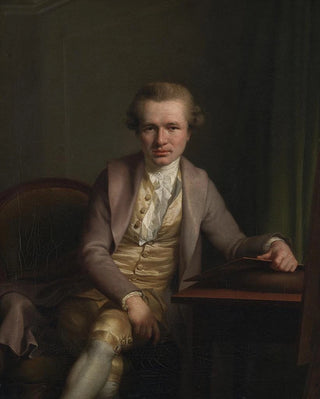Art print | The engraver Johann Friderich Clemens at his worktable - Jens Juel


View from behind

Frame (optional)
In the fascinating universe of Nordic art, the "Art print of the engraver Johann Friderich Clemens at his worktable" by Jens Juel stands out for its elegance and depth. This intimate depiction of an artist in the midst of creation immerses us in the artistic process, revealing the subtleties of engraving in the 18th century. Juel, a renowned Danish painter, manages to capture not only the essence of his subject but also the atmosphere of a studio where passion and technique meet. The soft light bathing the scene and the meticulous details of the decor invite the viewer to become part of this moment of concentration and creativity.
Style and uniqueness of the work
Jens Juel's style is characterized by meticulous attention to detail and mastery of light, giving his works an almost tangible dimension. In "Art print of the engraver Johann Friderich Clemens at his worktable," each element, from the furniture to the engraving tools, is carefully rendered, demonstrating the artist's technical skill. The composition is both simple and loaded with meaning, each object telling a story. The engraver's gaze, focused on his work, creates an emotional connection with the viewer, who is invited to share this moment of devotion to art. This ability to evoke deep emotions through scenes of everyday life is one of Juel's trademarks, who manages to transcend banality to reveal the hidden beauty of life.
The artist and his influence
Jens Juel, born in 1745, is often considered one of the pioneers of Danish romanticism. His training in France and his immersion in the artistic currents of Europe at the time allowed him to develop a personal style that combines realism and sensitivity. By depicting contemporary figures, Juel does not merely paint portraits; he captures the spirit of his era, offering a valuable glimpse into 18th-century Danish society. His influence is felt not only in his homeland but also in the development of Scandinavian painting. Artists who follow him draw inspiration from his ability to humanize his subjects,

Matte finish

View from behind

Frame (optional)
In the fascinating universe of Nordic art, the "Art print of the engraver Johann Friderich Clemens at his worktable" by Jens Juel stands out for its elegance and depth. This intimate depiction of an artist in the midst of creation immerses us in the artistic process, revealing the subtleties of engraving in the 18th century. Juel, a renowned Danish painter, manages to capture not only the essence of his subject but also the atmosphere of a studio where passion and technique meet. The soft light bathing the scene and the meticulous details of the decor invite the viewer to become part of this moment of concentration and creativity.
Style and uniqueness of the work
Jens Juel's style is characterized by meticulous attention to detail and mastery of light, giving his works an almost tangible dimension. In "Art print of the engraver Johann Friderich Clemens at his worktable," each element, from the furniture to the engraving tools, is carefully rendered, demonstrating the artist's technical skill. The composition is both simple and loaded with meaning, each object telling a story. The engraver's gaze, focused on his work, creates an emotional connection with the viewer, who is invited to share this moment of devotion to art. This ability to evoke deep emotions through scenes of everyday life is one of Juel's trademarks, who manages to transcend banality to reveal the hidden beauty of life.
The artist and his influence
Jens Juel, born in 1745, is often considered one of the pioneers of Danish romanticism. His training in France and his immersion in the artistic currents of Europe at the time allowed him to develop a personal style that combines realism and sensitivity. By depicting contemporary figures, Juel does not merely paint portraits; he captures the spirit of his era, offering a valuable glimpse into 18th-century Danish society. His influence is felt not only in his homeland but also in the development of Scandinavian painting. Artists who follow him draw inspiration from his ability to humanize his subjects,






